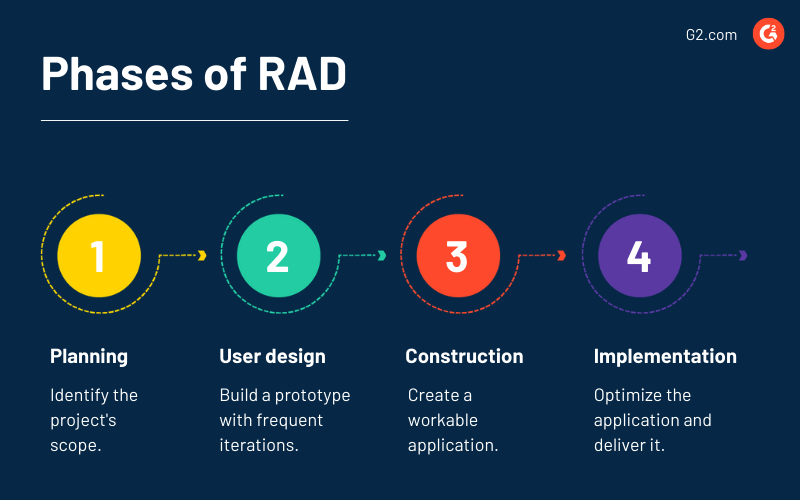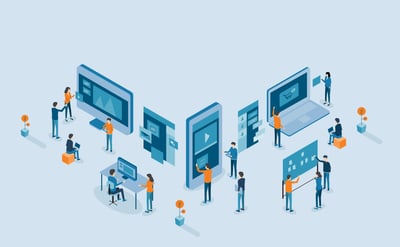
Technology evolves constantly.
Every business in today’s competitive landscape aims to provide new software and features to better serve its customers.
You need to build and deliver software faster to address your customers’ evolving needs before your competitors. It helps them get the encouragement they need to start and keep doing business with you while ensuring higher satisfaction.
Rapid application development methodology helps you meet the expectations of your clients as well as stakeholders in this ambitious technological space.
Rapid application development (RAD), also known as rapid application building (RAB), is an adaptive methodology of software development, where the focus is on quickly developing software prototypes and making frequent improvements based on continuous feedback. It’s an agile project management strategy popular in software development.
RAD follows an iterative and adaptive approach instead of a long drawn out planning, development, and testing cycle, making it suitable for you to deliver working applications quickly in a competitive software market.
While adopting RAD, you can leverage low code development platforms or no-code development platforms to expedite developing prototypes and workable applications.
The adaptive approach of rapid application development allows you to be more flexible and punctual in implementing client feedback and delivering the product. It also enables you to avoid redundancies that plague the Waterfall model. For example, within the Waterfall model, it becomes tricky to make modifications in software core functions once it has entered the testing stage.
The rapid application development approach is like working with clay instead of steel.
The RAD model’s flexibility helps you easily work with stakeholder’s feedback.
Here, you can modify the application’s core when needed without worrying about starting the development process again from scratch.
The RAD model aligns with expectations of the fast-paced technology market, enabling you to deliver faster.
Every product in today’s competitive market strives to be the most desirable and well-equipped with features that users need. With competitors deploying several features at scale, you need to be proactive in delivering changes that your customers expect. Rapid application development allows you to speed up the software development lifecycle by moving past the stretched planning and requirement gathering processes.
The RAD model enhances customer satisfaction by facilitating high-level collaboration of all stakeholders.
Throughout the RAD process, all software stakeholders collaborate while making desirable changes in the software. It helps all stakeholders to be aware and gives them foresight into what they can expect when the software is ready. It eliminates the possibility of unforeseen surprises in the final stages.
There are four phases through which applications are developed in the RAD methodology while achieving quick turnaround time (TAT).

Although RAD follows a condensed planning approach, it’s still one of the critical stages in the rapid application development model. It’s the stage where you identify a project’s scope and understand stakeholder’s requirements (timeline, budget, expectations, and goals).
The planning stage involves conducting a meeting with developers, stakeholders (users), and the team to reach a consensus on the best way to achieve the requirements fast.
A granular breakdown of the planning phase will present you with the following steps:
Teams benefit in this stage by avoiding confusion, minimizing costly changes, and achieving a transparent understanding of stakeholders’ requirements.
RAD’s principle portrays that requirements can alter during development, so the planning part is kept brief. It’s about gaining a concise idea of the project.
With a comprehensive understanding of the client’s requirements, you steer forward to the next phase of rapid application development – user design.
The user design stage involves rigorously working on building a prototype with frequent iterations. It requires clients to stay connected with developers and give precise feedback to ensure their needs are met.
Rapid prototyping and iterative development enable developers to make frequent changes and create a satisfactory design fast. It ensures that no potential changes or issues get overlooked, as the process is entirely transparent for all stakeholders right from the beginning.
Building prototypes make developers aware of component complexities and facilitates building robust, structured, and less bug-prone applications.
With a satisfactory prototype, you enter the construction phase, where you create a working model of the application.
Since many issues, tweaks, and changes get addressed in the design phase, it takes less time for developers, programmers, and testers to build workable applications. In this process, you have to stay connected with the client and ask for feedback to accommodate any alterations and ideas.
For simplicity, you can break down the rapid construction phase into smaller steps:
During the rapid construction phase, clients may find that some concepts in design phases don’t function as expected in practice. In such cases, you can go back to prototype iteration to find a possible solution.
When you receive positive user feedback, move to the next phase.
In this phase, all final changes are made in the application as the product is taken for launch. The implementation phase involves data conversion and full-scale testing to detect bugs and issues in the product.
The application is in a live production environment where teams optimize applications to ensure stability and maintainability.
The implementation phase also involves documenting, completing maintenance tasks, and providing user training before handing over the final product to the client.
The rapid application development approach focuses on creating applications faster with less attention on hardline planning and more on rapid prototyping and developing workable solutions. You can use low code development or no-code development platforms to minimize writing blocks of codes and create prototypes faster while reducing development time.
Low-code development platforms enable you to develop software with minimal coding. It doesn’t need extensive coding experience to prototype, build, or scale applications, as the platform provides base-level code scripts and integrations.
These platforms are well-suited for both developers and non-developers and help generate codes or provide element libraries for design through software such as robotic process automation (RPA). Custom RPA development helps improve productivity without abandoning unique design.
*These are the five leading low-code development platforms from G2’s Spring 2021 Grid® Report.
No-code development platforms empower businesses to develop software quickly without coding. You can use the WYSIWYG editor or drag-and-drop components to assemble and design business applications.
Both developers and non-developers can practice rapid application development with customized workflows and functionality. These tools differ from low-code development platforms in the level of customization one can achieve.
No-code development platforms provide relatively lesser customization and functionality as compared to low-code development platforms. With no-code development, you get more tools to organize information instead of accessing or modifying the source code.
*These are the five leading no-code development platforms from G2’s Spring 2021 Grid® Report.
Workplace innovation platform allows developers and non-developers to solve business challenges with collaborative development tools and ensure high productivity. The software enables non-developers to produce applications using free-form visual design tools.
Developers can leverage the platform’s full-stack development capabilities to fine-tune applications and expand functionality.
These platforms enable businesses to iterate on pace with their rapidly evolving business requirements using adaptive and robust app creation tools.
*These are the five leading workplace innovation platforms from G2’s Spring 2021 Grid® Report.
Choosing the right approach to application development depends on a variety of factors.
You can select the RAD model if you get a positive response when you ask these questions:
If your response is positive to all questions, you can choose the rapid application development approach. Still, there are certain things you need to consider.
For example, when working with more than one development team, their speed of work completion can be different. Since system integration can happen when both teams complete their work, it might prolong the estimated timeline of rapid application development.
System integration can further extend if there’s a difference in the logic and programming styles of the two teams.
These parameters have to be carefully planned and adjusted before proceeding with the rapid application development approach.
The rapid application development approach is beneficial for businesses, but it also has certain challenges. It’s essential to know the advantages and disadvantages of the RAD model before taking a step toward adopting it.
It’s advisable to know the benefits you can expect and understand if you can accommodate its challenges and still earn good business value.
Here are a few advantages of the rapid application development model.
RAD delivers better business functionality when all stakeholders frequently interact with the evolving prototype. It increases the application’s usability and makes it more reliable in addressing business problems critical to end-users instead of technical problems of the developers’ interests.
The RAD model inherently focuses on faster development and frequent client feedback. At the same time, it helps control risks. It considers critical risk factors and adjusts them based on empirical evidence collected in the early stages of the process.
Initial prototype designs help teams gain insights into the potential risks that could emerge in the development lifecycle. Developers make required modifications in the prototypes as risks appear in an ongoing development cycle.
With Rapid application development, you can focus on risks early instead of putting them on hold until the final product version is ready.
As the development occurs in incremental stages, the chances of any catastrophic failures are reduced, unlike waterfall models where failure is realized usually after a long time.
In the RAD model, if you encounter an issue, you can make changes in the prototype and construct the application. But in the case of the waterfall model, you would need to rethink the development process and start from the beginning to solve the issue or make additional modifications suggested by the client.
The rapid application development model allows you to break the project down into smaller and manageable tasks. This helps project managers assign tasks based on the professional's expertise and experience, increasing the entire team's efficiency.
Rapid application development also encourages reusing components. It helps testing units save time since the reused components are already tested, enabling teams to work on critical and fresh components of the product.
Here are a few disadvantages of the rapid application development process.
The rapid application development approach entails skilled and experienced development teams who can manage client's requests as they come. The team should be capable of accommodating client's expectations that might change in the course of the development lifecycle.
Teams trained in the waterfall approach or other software development approaches might be uncertain about adopting rapid application development. It can be due to their presumption that there can be a failure, considering they'll be learning the process for the first time.
Since RAD processes focus on less planning and rapid prototyping to ensure business functionalities critical to the client, attention to non-functional requirements is often sidestepped.
For example, non-functional requirements like privacy and security aren’t visible to clients in normal operations and might get pushed to the back-burner.
The RAD model requires consistent collaboration between all stakeholders in the project to navigate through the development process.
Sometimes, it becomes challenging to ensure constant cooperation from the client, depending on the client-side business’s willingness to invest their application domain expert’s time.
Since RAD dwells on an adaptable and flexible process, the control aspect of the project diminishes with increased flexibility.
Also, it may sometimes lead to poor prototype design with developers experimenting fast and loose with hit and trial hacks to achieve the required outcomes.
The RAD process is suitable for small and medium-sized teams. You’ll come across many challenges if you implement the RAD model for large-scale projects, considering lesser control and poor design outcomes of the approach.
The rapid application development approach facilitates faster development of applications and allows easy modifications with changing client’s requirements. Leverage the RAD approach to deliver software faster, with better quality and high client satisfaction.
Learn more about the no-code application development process to further reduce your turnaround time in software development and delivery.
Sagar Joshi is a former content marketing specialist at G2 in India. He is an engineer with a keen interest in data analytics and cybersecurity. He writes about topics related to them. You can find him reading books, learning a new language, or playing pool in his free time.
So, you want to be an Android app developer...
 by Bridget Poetker
by Bridget Poetker
The mobile industry is booming.
 by Bridget Poetker
by Bridget Poetker
So, you want to be an Android app developer...
 by Bridget Poetker
by Bridget Poetker
The mobile industry is booming.
 by Bridget Poetker
by Bridget Poetker


